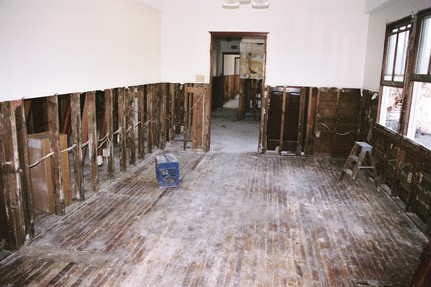
For communities that participate in the National Flood Insurance Program (NFIP), substantial damage determinations are required by local floodplain management ordinances after a flood event.
Substantial Damage Qualifications
It is common to think substantial damage merely describes a structure that has sustained a large amount of damage by a flood or other disaster. However, substantial damage is a specific term that applies to a damaged structure in a special flood hazard area (SFHA) — or floodplain — for which the total cost of repairs is 50 percent or more of the structure’s equalized assessed value before the disaster occurred. This applies to all buildings located in a designated SFHA, regardless of whether the building has flood insurance coverage and regardless of the cause of damage. Land value is excluded from the determination.
The decision about a structure being substantially damaged is made at the local government level, generally by the building/zoning official or floodplain manager.
Cost Determination
The total costs of repair include both structural and finished material and labor. The cost of repair is based on local market costs for the community and includes the cost of labor at prevailing wages.
Under Wisconsin regulations, structures substantially damaged by flooding must meet the elevation standards for new construction as stated in the local ordinance or if located within the floodway the structure must be relocated. Structures damaged by non-flood disasters must meet the NFIP elevation requirements as stated in 44 CFR 60.3. If a building is substantially damaged, no repairs can be authorized until the community determines if the requirements of the floodplain zoning ordinance can be met. Substantially improved structures are those structures which have had additions or been modified by 50% or more of the structure’s equalized assessed value at the time the work was proposed and is cumulative over the life of the structure. A builder’s estimate for the improvement is frequently used to determine the cost of the project.
Calculating Substantial Damage
To calculate substantial damage, the local official makes a visual inspection of a house, making notes of the impacts to the structure itself and, when possible, to the interior. The official uses these notes, coupled with other information such as property valuations and estimated costs to repair, to calculate the percentage of flood damage to the structure. Once a determination on the percentage of damage is made, local officials then share that information with the property owners. All flood damage repairs require permits from the local community. Property owners should contact the local building official to obtain permits before beginning the work. Depending on local codes and ordinances, not complying with the permitting process can have serious consequences.
Property owners who have a flood insurance policy and a substantially damaged building may be able to use additional funds from their NFIP flood insurance policy (up to $30,000) to help defray the costs of elevating, relocating or demolishing a structure. For more information on this provision, known as Increased Cost of Compliance, contact your insurance agent.
The DNR has more information available on Substantial Damage:
Substantial Damage Assessment Packet on how to assess flood damage or implement a substantial damage evaluation in a community.
Community Substantial Damage Plan Template
Permit and Public Notice Templates for a Community Substantial Damage Plan
Wisconsin Substantial Damage Implementation Plan
If you have any questions on the substantial damage process, please contact Brian Cunningham at brian.cunningham@wisconsin.gov
|